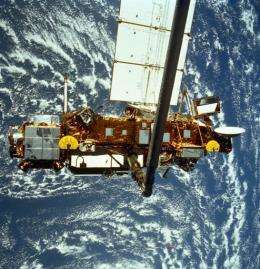NASA bus-sized satellite to crash-land this week

What goes up must come down. But where?
That's the big question when it comes to a 20-year-old NASA satellite the size of a tour bus which is careening toward Earth and set to crash-land later this week.
Update: NASA says satellite will hit Earth Sept 23 US time
The US Department of Defense and NASA are tracking the six-ton spacecraft, which poses a one-in-3,200 risk of hitting one of the seven billion people on the planet, the US space agency said.
But experts admit they will not know much more until the final 20 or so minutes before it lands, with a predicted re-entry date of Friday, September 23, give or take a day.
"We know it is going to hit somewhere between 57 north latitude and 57 south latitude, which covers most of the inhabited world unfortunately," said Mark Matney, an orbital debris scientist at the US space agency.
The Upper Atmosphere Research Satellite (UARS) was launched in 1991 to measure the ozone layer, wind and temperature. It was officially decommissioned in 2005.
It is the biggest NASA spacecraft to come back in three decades, after Skylab fell in western Australia in 1979, but Matney said similar-sized pieces of spent rocket and satellite debris fall to Earth rather frequently, given the global presence in space.
"Actually objects of this size come back on average once per year," Matney told AFP.
For instance, the much larger, 40-ton Russian space station Salyut 7 scattered over Argentina in 1991 after an uncontrolled return to Earth.
NASA has stressed that the risk to human life and property from UARS is small.
In 50 years of space exploration no one has ever been hurt by falling space junk, while it is much more likely that a person will be fatally struck by lightning, Matney said.
UARS reached the end of its useful life in 2005, and NASA used up the satellite's remaining fuel to lower its orbit so it would come back to Earth sooner.
If the US space agency had not done so, the satellite still would have made an uncontrolled return at some point, possibly 20 years or more down the line, Matney said.
As to the defunct satellite's much anticipated return, NASA has been issuing brief daily updates on a secluded part of its website.
The latest says only: "As of Sept. 20, 2011, the orbit of UARS was 127 mi by 140 mi (205 km by 225 km). Re-entry is expected Sept. 23, plus or minus a day.
"It is still too early to predict the time and location of re-entry. Predictions will become more refined over the next two days."
More frequent updates are scheduled for 12, six and two hours before it lands.
But even at two hours out, debris trackers will not be able to predict landing with an accuracy greater than 25 minutes of impact, or within a potential span of 7,500 miles (12,000 kilometers), NASA said.
"Part of the reason it is so uncertain is the spacecraft itself is rather unwieldy looking and it tumbles and we can't predict exactly how it is going to be tumbling," said Matney.
"Even as it tumbles that could change exactly where it is going to land."
Just 26 "potentially hazardous" pieces of the 35 by 15 foot (three by 10 meter) spacecraft are expected to survive the fiery re-entry into Earth's atmosphere, NASA said.
Those chunks will include titanium fuel tanks, beryllium housing and stainless steel batteries and wheel rims. The surviving parts may weigh as little as two pounds (one kilogram) or as much as 350 pounds (158 kilograms).
The debris is likely to scatter over a 500 mile (800 kilometer) area.
It will not fall at the same high speed it is traveling in space, and will not explode on impact because there is no fuel in it, Matney said.
The falling rate would be "equivalent to if you dropped something off an airplane," he said.
The Federal Emergency Management Agency, tasked with responding to major disasters, "is paying attention," said NASA spokeswoman Beth Dickey.
US Strategic Command's Joint Space Operations Center is "keeping everyone -- not just NASA but all the federal agencies that deal with public safety issues -- informed about where it is and predictions of where it's coming," she said.
NASA has warned people not to touch the debris if they come across it, not because it is toxic or flammable, but because such debris is likely to have sharp edges, explained Matney.
Also, "technically the debris belongs to the United States government," he added.
(c) 2011 AFP



















